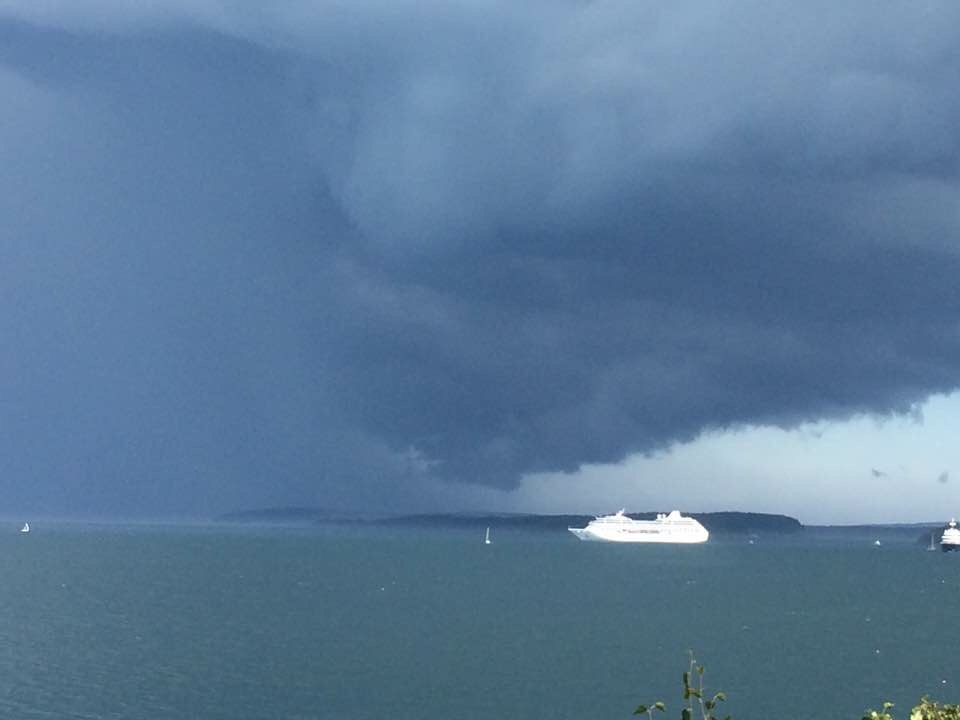Letter to the Editor-MDIslander by Gary Conrad
Suggested possible title: Cruise ships are like landfills
To the Editor:
Large cruise ships in Frenchman Bay cause two negative effects: one ecological, the other aesthetic. Both are being ignored by the committees considering the possible construction of a mega pier to host mega-size ships.
Ecological effects: The town of Bar Harbor has hired an excellent consultant who is helping to coordinate and facilitate the four major committees considering the type of pier to be built, but it has not hired an ecological consultant. Why not? Such a person is needed, not to do hands-on lab work, but rather to call up the studies of Frenchman Bay that already have been done and then to summarize the relevant results and make them understandable to the mostly non-scientific town councilors and committee members to help them make wise decisions, not only for economics, but especially for the ecological effects that cruise ship activities already have had and will have on the Bay. No consideration at all is being given to the economic effects that Bar Harbor Town Council decisions may have on the many businesses located along the N and E shores of the Bay that all depend on a healthy ecosystem in the Bay. That policy of blissful ignorance is a continuance of current practice. For example, no ecological impact statement has been prepared to assess the effects that steadily increasing numbers of huge, medium, and small cruise ships anchored in the Bay already have had, nor would have if tethered there via a megapier. The reasons for concern about economic effects are directly understandable by consulting the massive ecological study that was concluded relatively recently on the Bay, and written so that non-scientists can understand it: just go online and type “COA Frenchman Bay Atlas-2012”. That links to a 61-page summary of the ecology of the Bay, as well as its many marine-dependent businesses. Two relevant sections: p.17 is a map showing a huge (4 miles x 6 miles!!) area of sea scallop habitat directly in front of the pier location being considered for cruise ships! Moreover, the very large (20-ft diam.) propellers of the mega ships (2 per ship)(https://en.wikipedia.org/wiki/Oasis-class_cruise_ship ) stir up massive amounts of silt (https://www.keywesttravelguide.com/caught-on-satellite-key-west-cruise-ship-causing-huge-silt-plume/ ). That silt then is ingested by all filter-feeding shellfish (clams, mussels and scallops) directly below the ships, and then throughout the Bay, and coat adult, juvenile, and larval lobsters. That disturbance of silt also will have another effect: it will stimulate the growth of cyanobacteria (“blue-green algae”), leading to “algal blooms” that will be fed upon by the dinoflagellate organisms that produce the toxins associated with “red tide” (https://www.researchgate.net/publication/250220419_Grazing_by_Karenia_brevis_on_Synechococcus_enhances_its_growth_rate_and_may_help_to_sustain_blooms). Thus, more silt will increase the frequency of red tides in the Bay. Those events are a great, direct economic threat to the 6 companies that run aquaculture farms at the N end of the Bay (see the map on p.49 of the COA Atlas for their location, together with the normally low incidence of red tide closures in that region).
Aesthetic effects: A mega cruise ship is like a large municipal landfill: Both are huge and visually prominent. Both have smoke stacks that release toxic gases. Both are often brightly illuminated, 24-7. Both are financial generators for a limited number of people. Both contain the output of thousands of people. So, what working-class family would use its one week of annual vacation to load the dog and the kids into their old car to drive the many hours from NYC or Boston to come all the way to Bar Harbor to see a floating landfill, when they already can see cruise ships/landfills where they live? Instead, the family should focus on hiking and biking in Acadia National Park, the jewel of Maine.
Thank you.
Sincerely,
Gary W. Conrad
I have been a year-round resident of Bar Harbor since 2014. During 44 previous summers, I performed marine biological research at the MDI Bio Lab, Salsbury Cove, ME. I am an Emeritus University Distinguished Professor of Biology, Kansas State University.
